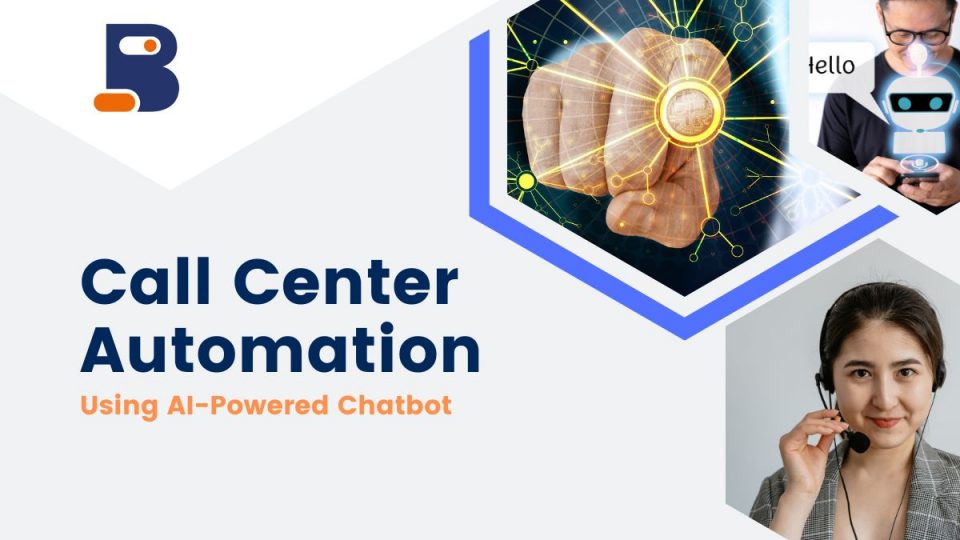In this modern business world, staying ahead of the competition needs consistent innovation and optimization. The most remarkable progress is customer service and support. Traditional call centers, while effective, can often be resource-intensive and time-consuming. This is where the power of AI-powered chatbots comes into play.
This blog post will explain about Call Center Automation using AI-Powered Chatbots, exploring their benefits, implementation, and the potential they hold for evolving customer relations.
Understanding Call Center Automation
Call center automation leads to the combination of technology, particularly artificial intelligence (AI) and chatbots, into the operations of a call center. The principal goal is to streamline and enhance customer support processes, ultimately leading to improved efficiency and customer satisfaction.
The Rise of AI-Powered Chatbots
In recent years, AI-powered chatbots have emerged as the driving force behind call center automation. These intelligent virtual agents are designed to mimic human interactions, providing customers with quick and accurate responses round the clock. Leveraging Natural Language Processing (NLP) and Machine Learning (ML) algorithms, chatbots can understand and interpret customer queries, offering solutions in real-time.
Benefits of Implementing AI-Powered Chatbots
The adoption of AI-powered chatbots in call centers brings forth a plethora of benefits that extend beyond just cost savings. Let’s explore some of the key advantages:
1. Enhanced Customer Experience
AI-powered chatbots redefine customer experiences by offering instant responses to queries, eliminating long wait times and reducing customer frustration. This immediate assistance significantly enhances the overall customer experience, leading to higher satisfaction rates.
Read Also: Top Tech Tools for Small Businesses
2. 24/7 Availability
Unlike human agents who work in shifts, AI-powered chatbots are available 24/7. This ensures that customers can seek assistance at any time, irrespective of time zones or holidays. Customers can receive support without delay even at midnight or during a public holiday.
3. Scalability and Consistency
As call volumes increase, hiring and training additional human agents can be cumbersome and time-consuming. Chatbots offer unparalleled scalability, efficiently handling multiple conversations simultaneously without compromising response quality or consistency. This capability enables businesses to provide consistent support, regardless of call volume fluctuations.
4. Data-Driven Insights
AI-powered chatbots gather valuable data from customer interactions. These insights can be analyzed to identify trends, pain points, and areas for improvement. By understanding customer preferences and common issues, businesses can enhance their services and tailor their offerings to meet customer needs more effectively.

Implementing AI-Powered Chatbots
Implementing AI-powered chatbots effectively requires careful planning and execution. Detailed guide about implementing AI-powered chatbots is as under:
1. Define Objectives
Begin by defining clear and specific objectives for implementing chatbots. Determine the specific tasks or inquiries the chatbot will handle, such as providing information, troubleshooting, or processing orders. Clear objectives guide the development process and ensure the chatbot’s functionality aligns with business goals.
2. Choose the Right Platform
Selecting the right AI-powered chatbot platform is crucial to successful implementation. Consider factors such as integration capabilities, customization options, scalability, and the platform’s ability to handle different types of interactions. A well-chosen platform will lay the foundation for a seamless and efficient chatbot system.
3. Design Conversational Flows
Design intuitive and user-friendly conversational flows that align with the defined objectives. Develop a comprehensive script that outlines potential user queries and the corresponding chatbot responses. Ensure that the chatbot can understand various user intents and provide accurate and relevant answers.
4. Integration with Existing Systems
Integrate the chatbot with existing customer support systems, CRM databases, and knowledge bases. This integration ensures that the chatbot has access to relevant customer information, purchase history, and previous interactions. By accessing customer data, the chatbot can provide personalized responses and streamline issue resolution.
5. Testing and Training
Thoroughly test the chatbot before deployment to identify and rectify any issues or inconsistencies. Simulate various user scenarios to ensure the chatbot can handle a wide range of inquiries effectively. Additionally, train the chatbot using real customer interactions to improve its accuracy and responsiveness over time.
6. Continuous Improvement
AI-powered chatbots are not a static solution but require ongoing improvement and refinement. Monitor the chatbot’s performance using metrics such as response accuracy, user satisfaction, and issue resolution time. Collect user feedback and use this information to iteratively enhance the chatbot’s capabilities and address any shortcomings.
The Future of Call Center Automation
The trajectory of call center automation points towards an exciting future filled with innovation and advancement. As the evolution of AI technology, chatbots will become even more sophisticated, capable of handling complex interactions seamlessly. The integration of technologies like voice recognition and sentiment analysis will further elevate the customer experience, enabling chatbots to better understand customer emotions and tailor responses accordingly.
Conclusion
In a world where customer satisfaction is paramount, the implementation of AI-powered chatbots for call center automation is a strategic move that can yield significant benefits. The ability to provide instant, personalized, and round-the-clock assistance not only enhances customer satisfaction but also allows human agents to focus on more complex and value-added tasks. As technology continues to advance, the potential for AI-powered solutions to reshape and redefine customer interactions is immense. Embrace the future of call center automation with AI-powered chatbots and position your business at the forefront of customer service innovation.
